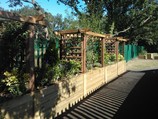Know your soil
The texture of soil can vary tremendously, but most areas of North East London tend to have a clay soil, so it’s probably worth concentrating on the main characteristics of this type of soil, which are;
1. Clay soils tend to hold water, which can cause them to become ‘claggy’ and difficult to work during wet periods, but on a positive note, during dry periods may require less irrigation than free draining soils.
2. Clay soils are generally fertile soils, with good levels of nutrients, such as Nitrogen and Potassium.
3. Due to high water levels, clay soils are generally cold soils and take a long time to warm up in Spring, which can delay plant growth.
It would be incredibly expensive and impractical to try to change your soil texture, but you can improve the structure relatively cheaply. The easiest way to do this is to dig in some organic matter, such as well rotted manure, which can improve air flow in the soil, improve drainage – as it stops clay particles from sticking together and it also adds nutrients to the soil, all of these factors will help promote healthy plant growth.
Add some Height...
There are many uses for climbers in the garden, such as; clothing a fence, or wall, disguising an unsightly structure, producing flowers or fruit, such as sweet peas and runner beans, providing screening and shade, using vertical space to provide further colour and interest within a garden.
Climbing plants will require support to grow, some more than others; climbers such as ivy have aerial roots which attach themselves to suitable surfaces, such as walls, while twining climbers, such as clematis will grow through and over supports such as trellis and wires. Other climbers may have lax stems which must be tied to a support in order for them to ‘climb’.
It’s important to choose the right support for your climber; heavier plants like wisteria will need a robust support, such as a pergola, while more delicate plants may need nothing more than plastic netting. Make sure that you choose the correct climber for the relevant conditions, planting a vigorous climber in a confined space will lead to regular pruning, so ultimate size should be matched to the space available.
Additionally you should also consider the pruning requirements of each climber and ensure that access to the plant for pruning is possible if it is required. You also need to consider the requirements of each climber before planting; south and west facing walls will offer greater protection for more tender plants, while others, such as climbing hydrangea are more shade tolerant and can be planted against north facing walls
SPRING FORWARD WITH YOUR GARDEN
A FRESH START IN THE NEW YEAR
2021 will soon be here and now is the time to consider the garden and get it ready for spring and the summer to come. Pose yourself some simple questions: Did the garden work for me and my family last year? Is the fence and perimeter secure? Were we able to entertain our friends and family in the way we would have liked? Is there enough green in the garden or too much greenery and not enough colour? The old pond is a bit of an eyesore and needs a makeover, but how? How do I sort out that rickety old path?
If you need some ideas or solutions to these questions or any others that make you look at your back or front garden and scratch your head then we can help.
Sometimes just a tidy up is all that's required. Other times it might require a professional eye to point out the possibilities and the solutions. At ABL Gardeners we offer a free consultation service that might be the best answer to some of those questions above. Call us on 07519 176 407 and we will be happy to pop over and chat over the best way forward with your garden.


